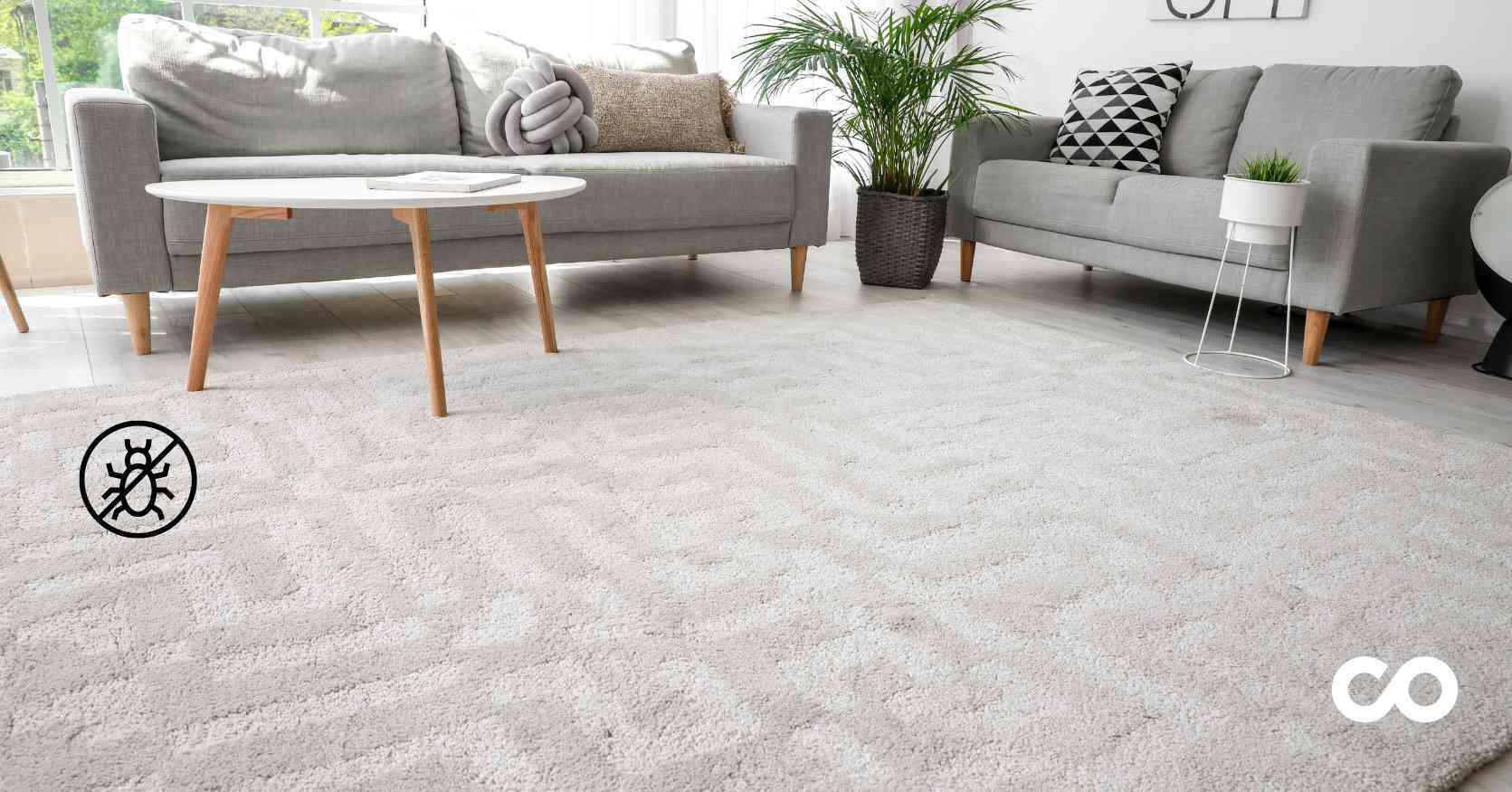Hypoallergenic carpet: Choose, Install & Maintain Guide
Author: Léo M.
This guide examines the benefits of hypoallergenic carpets for reducing allergies, provides advice for selecting and maintaining them, and offers tangible evidence through scientific studies conducted in Belgium.

Dust mites, harmful to health, tend to thrive in traditional carpets, causing allergies and respiratory issues. Temporary solutions like cleaning and over-the-counter chemical products often fail to eliminate them. The result? Continued irritation and further complications.
Fortunately, hypoallergenic carpet, thanks to specific technologies, offers a durable and effective solution for a healthy and comfortable indoor space. Discover in this article why hypoallergenic carpet could be the ideal choice for your health.
What is Hypoallergenic carpet?
Definition and characteristics
Hypoallergenic carpet is designed to repel micro-organisms responsible for allergies. These carpets are made from specific materials and treated with dust mite-resistant agents to prevent their proliferation.
Synthetic fibers like polypropylene, polyester, and nylon are commonly used for their resistance to dust mites. These carpets reduce the presence of allergens, creating a healthier and more comfortable indoor environment.
Differences with traditional carpet
Modern carpets differ from traditional carpets through the use of more durable or eco-friendly materials, incorporation of innovative technologies like stain-resistant or antimicrobial treatments, and adoption of advanced manufacturing techniques for improved durability.
Additionally, they offer a wider variety of designs, patterns, and textures due to advancements in design and production techniques.
This type of carpet is generally more expensive because it features advantageous technical characteristics (thermal retention, acoustic optimization, etc.) and is most commonly installed in professional spaces, primarily offices.
In Belgium, hypoallergenic carpet is popular in bedrooms and professional spaces for its ability to improve air quality.
-1.webp?width=1024&height=768&name=ENG%20(2)-1.webp)
Health Benefits of Hypoallergenic Carpet
Reduction of allergies and respiratory issues
As you might expect, one of the main benefits of hypoallergenic carpet is the reduction of allergies. Dust mites are microscopic creatures that feed on skin flakes and thrive in warm, humid environments like regular carpets. The feces and other debris they leave behind can trigger allergic reactions such as sneezing, itching, and respiratory problems.
Even though they are small, it is important not to neglect the effectiveness of a good treatment and proper cleaning to minimize their nuisance. People suffering from asthma or allergic rhinitis often notice significant improvement in their symptoms after installing hypoallergenic carpet.
Improvement Sleep and Well-being
In addition to reducing allergies, hypoallergegnic carpets have a positive impact on overall quality of life and well-being. A healthier indoor environment means fewer sick days, fewer doctor visits, and less need for allergy medication.
The reduced presence of allergens also contributes to better sleep. Sleep disturbances caused by difficulty breathing or nighttime itching are common among allergy sufferers. By eliminating or minimizing these triggers, an hypoallergenic carpet can lead to more restful and restorative sleep.
Imagine the positive effects on energy, mood, and productivity!
It’s important to note that children, elderly individuals, and those with weakened immune systems particularly benefit from a well-maintained hypoallergenic carpet.
Thermal and Acoustic Comfort
Hypoallergenic carpet, with their advanced technology and versatile technical features, can also contribute to thermal comfort by insulating the floor and helping to maintain a more consistent temperature in your professional space.
Additionally, they can absorb noise, which undeniably helps create a quieter and more conducive environment for concentration.

How to choose the Right Hypoallergenic Carpet?
Option for hypoallergenic carpet is an excellent decision for improving indoor air quality and preventing allergies. Even if you're convinced, you still need to navigate the diverse range of products available on the market. It's essential to know how to choose a carpet that suits your needs, which is why we will provide you with expert advice based on our extensive experience in the industry.
This guide will help you understand the key selection criteria and compare different brands and models.
Selection criteria in Belgium
When choosing an hypoallergenic carpet, several criteria should be considered to ensure its effectiveness and durability. Here are the key elements to consider:
-
Choose quality materials: We recommend opting for synthetic fibers such as polypropylene, polyester, or polyamide. These materials are commonly used in professional spaces and are known for their ability to resist dust mites. They are also relatively easy to maintain with the right methodology and offer good durability over time.
-
Check athe dust mite treatments: Some carpets are treated with specific substances to eliminate or repel dust mites. Ensure that you verify the nature of these treatments and their safety for health. Prefer treatments that are certified and specified as non-toxic and hypoallergenic.
-
Look for certifications: In Belgium, the Benor label and the Vinçotte certification are good indicators of quality. At the European level, the EN 14041 standard ensures the safety and durability of carpets, while the ISO 22196 standard measures the antimicrobial activity of dust mite treatments. For long-lasting maintenance, choose a certified cleaning service.
-
Choose the right fiber density and height: A dense carpet with short fibers is more effective at preventing dust mites from lodging in it. Additionally, it is easier to clean, which helps reduce the buildup of dust and allergens while promoting more frequent renewal of the carpet’s natural filter.
Comparing Different Brands and models of Hypoallergenic Carpet
The market for hypoallergenic carpets is vast and varied, with many brands promising effective allergy solutions. Here are some points to help clarify the different options available and choose a qualified provider for extending the carpet's lifespan.
-
Check consumer reviews: Read feedback and reviews from other consumers. Testimonials can provide valuable information about the effectiveness and durability of a specific hypoallergenic carpet.
- Evaluate prices: Compare different brands and models to find the best value for money, considering features and certifications. A more expensive carpet is not necessarily the best, but be cautious of very cheap products that may lack effectiveness. Find the best affordable carpet for your business.
-
Prioritize warranty and after-sales service: Choose brands that offer a warranty on their products. A good after-sales service policy is also an indicator of the manufacturer's reliability.
Installation of Hypoallergenic carpet
Installing your hypoallergenic carpet correctly is essential to ensure it performs optimally. For this step, we recommend hiring professional installers who can guarantee an efficient and technically sound installation
Steps for installation
First, remove the old carpets or other floor coverings by following our 6 steps for better preparation of the installation. Next, here are some practical tips that will always be useful if you plan to install carpet in your offices.
-
Prepare the floor: Vacuum to remove any dust and debris. If necessary, use an antimicrobial solution to disinfect the floor.
-
Install the underlay: Choose a hypoallergenic underlay to enhance comfort and extend the lifespan of your hypoallergenic carpet.
-
Cut and adjust: Allow it to acclimate to the room for 24 hours. Then, measure and cut the carpet to fit the dimensions of the room, ensuring to leave a few extra centimeters at the edges for precise fitting.
-
Secure and adjust the carpet: Use a special adhesive or allergy-resistant tape to fix the carpet to the floor. Ensure the carpet is tightly stretched to avoid wrinkles and bumps. Trim any excess carpet and add baseboards or transition strips for a clean finish.
Maintenance Your Hypoallergenic carpet
Tips for effective and long-lasting maintenance
Regular maintenance is essential to keep the dust mite-resistant properties of your hypoallergenic carpet and maintain a clean and comfortable environment. Here are a few tips for optimal maintenance:
Here are some tips for optimal maintenance:
-
Vacuum regularly: Vacuum the carpet two to three times a week with a vacuum cleaner equipped with a HEPA filter. This helps reduce allergies by removing dust mites and other allergens.
-
Deep clean periodically: Perform a deep cleaning every six to twelve months. Use hypoallergenic cleaning products or hire a professional for a thorough cleaning.
-
Treat stains immediately: When stains occur, clean them quickly with an appropriate carpet cleaner.
- Control humidity: Maintain a low humidity level in the room, between 18 and 20 degrees Celsius, to prevent dust mite proliferation. Use a dehumidifier if necessary.
By following these steps and tips, you'll be able to maintain your anti-dust mite carpet like a pro, keeping the air quality at a recommended level.
Also read > What is the Average Carpet Cleaning Price in 2024?
Case studies on the use of Hypoallergenic carpets
Scientific studies conducted by the Carpet and Rugs Institute
A study performed by Airmid Healthgroup, an independent biomedical research group, designed and evaluated by Dr. Bruce Mitchell ( CEO Airmid Chaiman) , reveals that properly cleaned carpets trap allergens, reducing airborne particles and improving indoor air quality for asthma and allergy sufferers. The research also shows that carpets, when maintained, contain less dust and allergens compared to hardwood floors, making them a healthier option.
📋 Conclusion :
Hypoallergenic carpets provide a highly effective solution for better control of unwanted elements in your space. With its specific materials and appropriate anti-dust mite treatments, it is a reliable and hygienic choice for both residential and commercial spaces.
5 Key points to remember:
- Allergy Reduction: Thanks to its naturally filtering properties, anti-dust mite carpet minimizes the presence of dust mites, significantly reducing allergy symptoms.
- Improved Quality of Life: It promotes a fundamentally healthier indoor environment for occupants
- Thermal and Acoustic Comfort: An anti-dust mite carpet also provides better thermal insulation for your floor. Additionally, it absorbs sound, creating a quieter and more comfortable environment.
- Selection Criteria: The selection should consider materials, certifications, and fiber density to ensure effectiveness and durability.
- Regular Maintenance: Frequent maintenance, including vacuuming and deep cleaning every six months, is crucial to maintain its effectiveness and extend its lifespan.
Need Advice?
Active in the carpet maintenance and reuse sector for over 30 years, we invite you to share your thoughts or contact us for personalized advice on choosing new carpets.
FAQ - Anti-dust mite carpet
Who are dust mites, where do they live, and how can they be eliminated?
Dust mites are arachnids that feed on dead skin cells. They thrive in warm and humid environments, such as mattresses, pillows, carpets, and upholstered furniture. To eliminate them, it is crucial to maintain a room temperature between 18 and 20 degrees Celsius. Additionally, it is recommended to air out the room for fifteen minutes in the morning and evening, and to avoid indoor plants, as they are sources of humidity.
Is carpet worse or better for allergies?
Carpet can be beneficial for allergies if it is anti-dust mite. These carpets, treated to resist allergens, improve indoor air quality. A study article showed that they reduce allergy symptoms. By choosing and regularly cleaning an anti-dust mite carpet, one can have a comfortable floor while minimizing the risks of allergies.
Do vacuum cleaners kill dust mites?
Using a vacuum cleaner can help reduce their number by removing dust and debris where they reside. Models equipped with HEPA filters are more effective because they capture fine particles and allergens, including dust mites and their droppings, thus improving indoor air quality.
What is the dust mite season?
Dust mites can be found year-round in the more temperate regions of Europe, such as the West and North. This includes countries like the United Kingdom, France, Germany, the Netherlands, and Belgium, where winters are not excessively cold and indoor humidity levels generally remain high. These conditions create a favorable environment for dust mites to thrive. Understanding that dust mites are present throughout the year can help in managing and reducing their impact, regardless of the season.
%20Use%20%E2%80%94%20Electric%20Blue.png) Clean and maintain my carpet
Clean and maintain my carpet %20Reuse%20%E2%80%94%20Eco%20Lime.png) Sell my carpet or buy sustainably
Sell my carpet or buy sustainably %20Recycle%20%E2%80%94%20Fresh%20Plum.png) Remove and recycle my carpet
Remove and recycle my carpet .webp?width=2000&height=1414&name=ENG%20(2).webp)